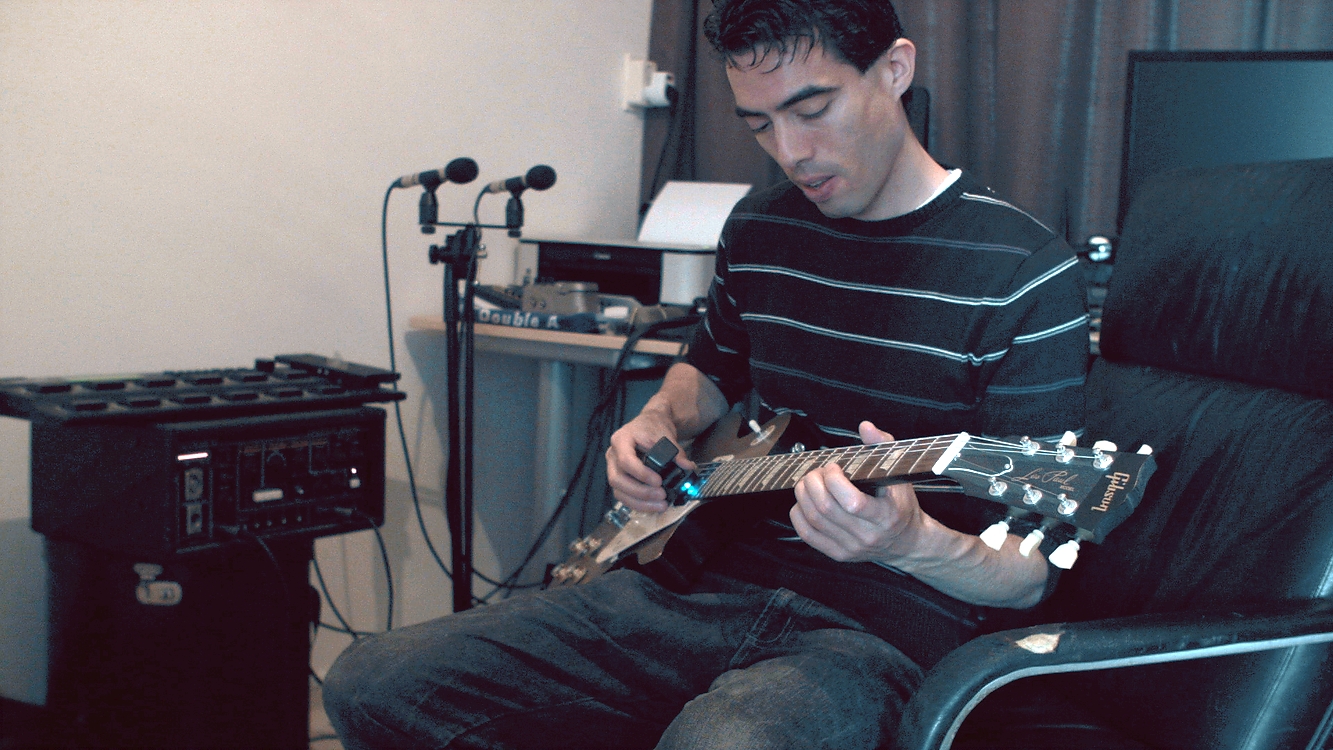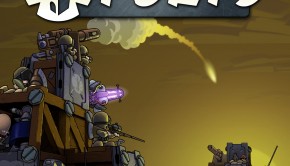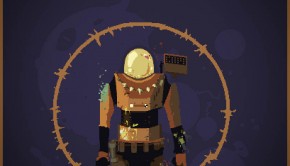Siddhartha Barnhoorn Interview: Galactic Inspirations
Siddhartha Barnhoorn is a prolific and versatile composer who has worked on numerous films, indie games, and original albums over the years. He’s been known for his music featured on the games Antichamber, Out There, and The Stanley Parable.
In this interview, Barnhoorn discusses his origins, discovery, and diversification of his composer. He puts special focus on the making of the distinctive sounds of Antichamber and Out There, as well as highlights from his film, commercial, and album reels. The interview is supplemented with streamed soundtracks spanning his origins to the present.
Interview Credits
Interview Subject: Siddhartha Barnhoorn
Interviewer: Chris Greening
Editor: Chris Greening
Coordination: Chris Greening
Interview Content
Chris: Many thanks for talking to us today, Siddhartha Barnhoorn. First of all, can you tell us about your musical background?
Sid Barnhoorn: No problem, Chris and thank you for giving me this opportunity! It began early in my life. I became a big Star Wars fan first time I saw it as a kid, and the music always stuck with me. For me it sounded amazing and I loved the themes, same with the soundtrack for Krull by James Horner. These were just a few of the soundtracks that I can vividly remember that inspired me. I never thought about becoming a composer myself at that age though… After all, I never thought I would be able to do that — play an instrument or compose music. This came later…
I was born in 1981 so as a kid I saw a lot of cartoons with lots of fantastic melodies and themes. I also enjoyed looking at the Sky Channel, which in that era was a kind of MTV, showing music videos etc. Loved that! I also was into computers from a very young age because my dad is a programmer and he had a lot of PCs in the house when I was growing up. So, I played a lot of games in the 80s and 90s through till now. I even still own my very first NES with all the original games, which my dad bought for me when I was a kid. My dad used to play a lot of great prog-rock and electronic music when I as growing up too, like Pink Floyd, Camel, Kitaro, Van Der Graaff Generator and a lot of other great bands.
The interest for playing an instrument came when I was an early teen. This came slowly though as the seeds were gradually planted here and there. We went to friends of my dads a lot in the weekends and they had a Roland keyboard, which I loved to play on after dinner. I remember finishing up dinner and asking if I could play on the keyboard upstairs. They didn’t see me until my dad said we were going back home!
In my mid teens I got an old electric guitar from my uncle which I learned to play by myself by trying to find the melodies of the bands I liked to listen to a lot at that time, like Pink Floyd, Camel and Blind Guardian. A few years later I tried the same with film music, trying to find the chord progressions and voice leadings of certain passages in the soundtracks of James Horner and John Williams among others. Later, I would record my own music, mainly rock/metal style works with just guitar and some rough midi instruments. I then found GigaStudio with which I could load Giga samples which were, at that time, amazing. played around with them to compose orchestral works.
Chris: What then led you on the path to becoming a film and video game composer?
Sid Barnhoorn: It was not until around 2003/2004 that I seriously began considering composing for film. A friend of mine came by to listen to some of my music and he told me it sounded like film/game music and asked if I would consider composing something for film or games. It didn’t cross my mind until he said it and he got me in touch with an animation student from the HKU. In 2004 I composed my first film score for a short film called Temple Tumble. And after that, I was on fire: from 2004 till now I’ve composed music for over 70 movies.
It was later that I also got into composing music for games. My first serious game was Antichamber which was also a great success. Before I got onboard for Antichamber, I had experimented a lot with composing ambient/electronic music in my free time, which is still something I enjoy doing. After a lot of experimenting and composing, I released my first ambient solo album Pillars of Light. This was in 2011, and in this same year Robin Arnott contacted me if I was interested in working with him and Alexander Bruce on Antichamber. It was a great experience seeing it all come together and being able to work parallel with the development of the game. With film, you usually get into the project at or near the end of post production, so this was a nice change of pace and a new challenge for me.
Chris: Listening to your demo reels, you’re incredibly versatile. Can you tell us how you became so adept at a range of genres? How did you develop expertise in ethnic, electronic, and orchestral music?
Sid Barnhoorn: I was very interested in various styles of music when I was a kid and this grew more when I did my studies at the School of the Arts and continued well after that. I try to find projects that challenge me to do something different in what I usually do. This can sometimes be difficult but I enjoy the challenge and it is satisfying when I am able to get it right!
For the ethnic music, I have always been interested in traditional and folk music from different places in the world. I studied some of this at the School of the Arts, for instance music from Japan and China. In that period I also bought some of the traditional instruments like the shakuhachi from Japan and the Armenian duduk, and learned how to play them.
Electronic and orchestral music always came more natural to me and, by doing all these different projects, I was able to get better at orchestration, production and bringing together the sound as a whole. I did a lot of projects where I composed mainly orchestral music at first, with those that needed electronic/ambient music creeping in. It takes time, patience and keeping at it, keep on working and learning.
Chris: As a game composer, you’re perhaps best known for your work on Antichamber as you say. Could you tell us your inspirations for this rich, timbral score? How did you evolve your tracks over the course of the game?
Sid Barnhoorn: Alexander Bruce, Robin Arnott and me had discussion about this early on in the process. We decided to go with ambient, subtle music so the player would get fully immersed into the game. This was a nice new challenge for me because it forced me to restrain myself from doing anything that would be too loud or anything that would take away from the immersive experience.
To make it more interesting I thought it would be a great to have the music evolve, as the player evolves more into the game with a few moments to trigger an evolution in the music, in this case when you find a gun. The music started out at its most subtle point, with one layer, the ambient layer. I made variations on those ambient layers per level. With each level the tonality would change and the density as well, making the journey through the game more organic. On top of those ambient layers, I made another layer which was more melodic / rhythmic in nature. These would come in later in the game. Also these layers had multiple variations. The variations in all layers would cross-fade from one to the other, each also with different lengths, making the music organic but also a little different each time.
My main inspiration are ambient artists like Steve Roach, Brian Eno and Robert Fripp. Also Tangerine Dream and Alpha Wave Movement. These are some of my favorites and definitely influenced me in my ambient musical journey and still do.
Chris: The sounds of Antichamber are top-notch. Can you tell us how you have achieved this? What hardware and software do you use to bring your music to life? Do you also work with performers?
Sid Barnhoorn: In terms of the timbre of the sounds, I used a mix of synthesizers and also a lot of guitar work to create those sounds. As well as percussive sounds from EWQL and a few older sounds I still had from my GigaStudio days, from a library called EthnoWorld. I recorded the guitars myself as well as some of the ethnic woodwinds. For my main sequencer I use Cubase.
Chris: You adapted the in-game music for Antichamber into an incredible soundtrack album. How did you achieve this ambitious track? How did you immerse listeners into tracks such as the Antichamber Suites?
Sid Barnhoorn: It was a challenge to create a soundtrack being everything in the game loops and consists of layers. I took these tracks / layers and tried to make something coherent with them. I think and hope I was able to catch the essence of Antichamber in those tracks.
Chris: On the note of music releases, you also released your own ambient music album Pillars of Light. Could you discuss the concept of this album? How did it compare to working on a soundtrack?
Sid Barnhoorn: Pillars of Light was my first ambient solo album release. I actually had a lot of conceptual ideas when I was working on it, but it felt daunting to me at the time so I figured I will just start composing and see where it will take me. I did have a kind of sci-fi / space concept in my mind but it was more abstract. I used to look at the Astronomy Picture of the Day each day, which inspired me a lot, and I used that inspiration to compose!
Compared to working on a soundtrack I had a lot more time and not a real clear direction of where I was going. With working on a soundtrack you basically tell a story and the context of the project helps a lot with that. That said, the track “The Floating World” did end up being used from the album in The Stanley Parable. I am currently working on my second ambient album!
Chris: Projects such as Antichamber and Pillars of Light seem deeply personal, but you’ve also worked on a wide range of commercials and other projects where there is presumably less freedom. How have you kept the flexibility to meet the needs of diverse clients? Are these projects still satisfying to work on?
Sid Barnhoorn: For me, it is work, so I do it even though it sometimes is not what I would ideally like to do. For instance, I worked in trailer and library music for a short period of time, but it was eventually not my cup of tea. I still do work for commercials though when they ask me. Looking back I feel that the commercial Embrace Life – Always wear your seatbelt is a good one. It also happens to be one of my most listened to and best-known works, as it went viral on YouTube in 2010.
My main bulk of work now comes from films, documentaries and games. After all, film was the reason I got into composing in the first place and also why I wanted to do it professionally. Later also games, which is now also one of my favourite mediums to compose for!
Chris: Film-wise, what projects are the biggest highlights for you and why?
Sid Barnhoorn: The British psychological thriller BROKEN, a short film which premiered in September 2016 and also went viral on YouTube. It is a 80s/Spielbergian style adventure film where I had the chance to compose in a style that I had yearned for: orchestral action/adventure style in the vain of John Williams, one of my heroes. The score was co-composed by Dan Dolby; while we worked separately, our contrasting approaches complemented the film very well. I’m very happy with how that film turned out.
Chris: Another of your best-known soundtracks is Out There. How did you capture the sense of a boundless space adventure on this title? How did you expand on it for Out There: Omega Edition?
Sid Barnhoorn: I’ve always been into astronomy, sci-fi, and science. Ever since I was able to compose with orchestral samples I started work on music inspired by those themes and I composed my “Space Suite”, which I finished in 2003. Many years later I got better at working with synth libraries and also making my own sounds and in 2011 I did my solo album Pillars of Light, which was kind of my step towards being able to compose for something like Out There.
By the time I got asked to compose for Out There, I had already done some demoing work for The Unfinished, a project by Matt Bowdler where he makes synthesizer presets for various synth software like Native Instruments FM8, Absynth, Massive, u-he Zebra and many others. These sounds along with some tweaking and my own sounds gave me the inspiration to compose for Out There.
With Out There: Omega Edition I was asked to compose more music so I had to think about a way to expand it and we came to the idea of having specific music per star type, mainly specific in mood. And for the garden planets I wanted to use voice in an otherworldly way. Lara Ausensi did a great job with her voice at bringing that to the music.
Chris: You’ve got several projects in production. Can you tell us more about what we can expect from you in the future?
Sid Barnhoorn: I am currently working on about six video games, namely:
– Planet Alpha 31, a sci-fi platformer.
– Semispheres, a puzzle game.
– Don’t Kill Her, a kind of fantasy platformer.
– Thunder Highway, which is a tribute to the old Godzilla movie.
– Voidrunner, a fast-paced sci-fi flight simulator.
– And also the latest project by Miclos Studio, the makers of Out There!
All these games are very different and will bring each their own challenge with different music. I also recently finished music for a Moroccan feature film called Mon Oncle, which is a comedy/drama. Lots of fun to work on and something very different from me — more jazzy.
Chris: Many thanks for your time today, Siddhartha. Is there anything else you’d like to say about yourself or your works? Do you have any messages for your fans around the world?
Sid Barnhoorn: Thank you so much for taking the time to ask me these questions. It was a pleasure. I also want to thank all my fans for the support that they give me. I feel honoured and grateful for your appreciation of my work.
With each project I do my best to give the best for that particular project. Currently I’m doing a lot of ambient / synth based works and I am experimenting with new approaches to do something new. At the moment I do this by using more hardware synthesizers as well from the vintage Korg MS-10 to the modern Moog Mother 32.
Posted on January 29, 2017 by Chris Greening. Last modified on January 29, 2017.















